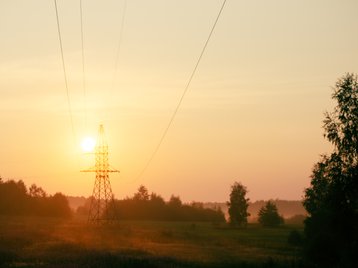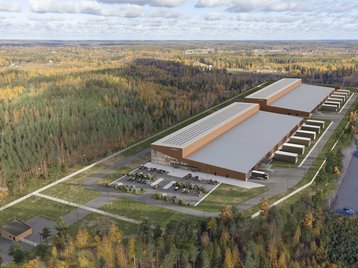Finland is the happiest country in the world. Don’t take our word for it – that’s the result of the United Nations’ World Happiness Report, which has placed Finland at number one for six consecutive years. Who wouldn’t want to build their data center infrastructure in such a joyous place?
If you’re not already convinced, the Finnish Data Center Association (FDCA) is here to persuade you. As it enters its tenth year of operation, board member Mikko Aho spoke to DCD about the story of the group, and its plans to grow the Finnish data center industry even further during its second decade.
We start back in 2014, with a potted history of how the organization came to be. Aho tells all:
“The association was started to support ISO standardization work. At that time, Finland was one of the poor runners in the data center industry. We were already thinking about the next step on energy efficiency and cost. We were already reusing some heat from data centers, which we considered very beneficial, so we wanted to create a standard based on that. Finland went on to become a frontrunner in the energy reuse factor.
“Back in those days, the main purpose of the association was to raise funds from companies in the industry to support our standardization work. But even then, we thought maybe there was something more to it. Nowadays, the association looks after industry interests in Finland by increasing and promoting awareness, to create more business opportunities. We don’t just think, we have proof that this is the best place to locate your data center. Nowadays, in addition to looking after data center interests, we also support education, and of course, we promote sustainability.”
Bold claims from a country known for speaking its mind. If you’d like to learn more about why Aho feels so certain, you can read our interview with the FDCA that examines the advantages of locating in Finland, but he sums it up here:
“The physical environment, the political environment, and many other things support the fact that big data center operators should locate their data centers and finances here. Heat reuse is easy here. The main cities already have a district heating network, which can be easily utilized.”
As FLAP-D locations become more saturated in terms of both space and resources, Finland is perfectly placed to be the next big thing in data centers. Aho tells us:
“In the past decade, there's been a massive increase in data, and in the size of data centers. The Covid epidemic was one moment in the history of data centers when there was a huge peak towards cloud services because everybody wanted to work remotely, all of a sudden. Companies wanted to invest in putting everything on the cloud. But at the same time, we have also seen good energy efficiency and sustainability development.
“The European Union is also taking actions to guide the industry in the right direction, but the industry itself has taken the first steps even before regulation comes from governments. We have seen things like the founding of the Climate Neutral Data Center Pact which brings together the norms and guidelines that the industry should follow when it comes to energy efficiency and sustainability. The Association has evolved to become a well-recognized expert representative for the industry.
“We started small, but now we have created a good dialogue between the industry and the government. All the main players in the industry participate, with representatives from all the major data center companies in Finland, and in many cases, on the board, so it is very beneficial for the industry. We are also doing a lot of cooperation with other associations, to influence how their sustainability will develop.”
Education never ends
There’s certainly been no time for Kalsarikännit* over the past decade, as educating the world about the value and purpose of data centers has formed a large part of the Association’s sisu**:
“People only see headlines about, for example, Bitcoin mining, and these kinds of negative issues, which hurts the image of data centers quite a lot. Data centers also bring so much good, and we have been doing quite a lot to change the image of the industry, since without data centers, we can do… pretty much nothing.”
A more disturbing issue, perhaps, is that much of the first decade for FDCA has involved speaking truth to power who really should know better.
“When we started, the government, the ministries, and other decision-makers didn't understand what data centers are, and why they are such an important part of the whole infrastructure. Some decision-makers question why we need data centers, fiber cables, or fiber networks since we have Wi-Fi and 5G networks – the level of understanding was that limited!
“We have tried to teach, right from the basics, what a data center is and how valuable they are. There have been a lot of business opportunities around data centers and the number of workplaces they create – people working in and around, maintaining facilities, and that’s not even mentioning the construction. I also try to underline how they have been an important part of introducing more sustainability to the city ecosystem.”
Education doesn’t begin and end with top brass however and with that in mind, the FDCA has introduced the idea of a career in data centers at the grassroots level too.
“We cooperate with schools and universities because the data center industry in Finland is suffering from the same issue as the rest of the world, in that we have a shortage of qualified and competent people around, making it challenging to find suitable employees in technical industries. The association has been encouraging the introduction of data centers into the syllabus, and even participating in teaching since we have a lot of expertise in our Association, making it easy to find suitable teachers to give lessons to the students about what a data center is and how it combines other areas of technology.”
The heat is on
At the heart of Finland’s claim to be the perfect location for data centers is its history of spearheading the reuse of waste heat for domestic use. As the practice becomes more widespread, Aho tells us how the FDCA is working to demonstrate to the rest of the world how it’s done.
“ISO standards are global, so whenever there's a new standard published, it soon spreads around the world. The European Union is launching a New Energy Efficiency Directive this year, setting up the norms and KPIs for data centers. It’s now up to governments to do the legislation locally, but because we only have about five or six million inhabitants in Finland, we have a history of making things work in a very efficient way.
“That’s why we’ve been ahead of the curve in heat recovery before a standard was established. Two years ago, a local law was finalized, giving tax benefits to data centers utilizing heat recovery in their facilities. Now that it has spread across Europe, we can show the world how we made it happen.”
Future Finnish
Now that the FDCA has established itself as the authority on all matters of Finnish data, we ask Aho what the second decade has in store:
“We want to be an even more professional association. We have two employees working, part-time, but what we want to do in the future is to have an association that works like a company, with a managing director or CEO and employees who are actively promoting the industry, in Finland, in Europe, and trying to create even better knowledge globally, that Finland is on the data center map of the world, and show what we can offer the sector. The end game is to become even bigger but also work in an even more personal way.”
With this increased infrastructure comes increased cooperation with partner countries, as well as continuing to spread the Association gospel through events, not least of all the flagship Future Data Summit:
“We are doing a lot of cooperation with the Nordic Association, the Swedish Data Center Association, for example, and also with the Dutch Data Center Association, with whom we hold joint events. We also have a combined Nordic Association Board, where we regularly exchange opinions and look for ways to introduce or attract international companies to come to the Nordics.
“Our next event will be a round table for our members, on the 22nd of November, where we will outline next year's targets and strategy. The next main events are the Spring events, which will take place in April or May next year. And not forgetting, the tenth Future Data Summit, which will be held in October 2024.”
Aho repeatedly emphasizes the open and welcoming environment of FDCA, so we finish by asking him how to get involved:
“Everybody can become a member, free of charge, so if you want to join us, as an individual or as a company, you can. Companies who join become sponsoring members. The biggest benefit is access to events where they can meet all the major data center industry members, grow their network, and promote any business opportunities coming up.”
And that’s not forgetting that you will be surrounded by the happiest people in the world – as proved by science.
(*a Finnish term for getting drunk at home in your underwear)
(**a Finnish term for a stoic sense of purpose and ambition)
To find out more, contact the Finnish Data Center Association on [email protected] or visit https://www.fdca.fi/.


